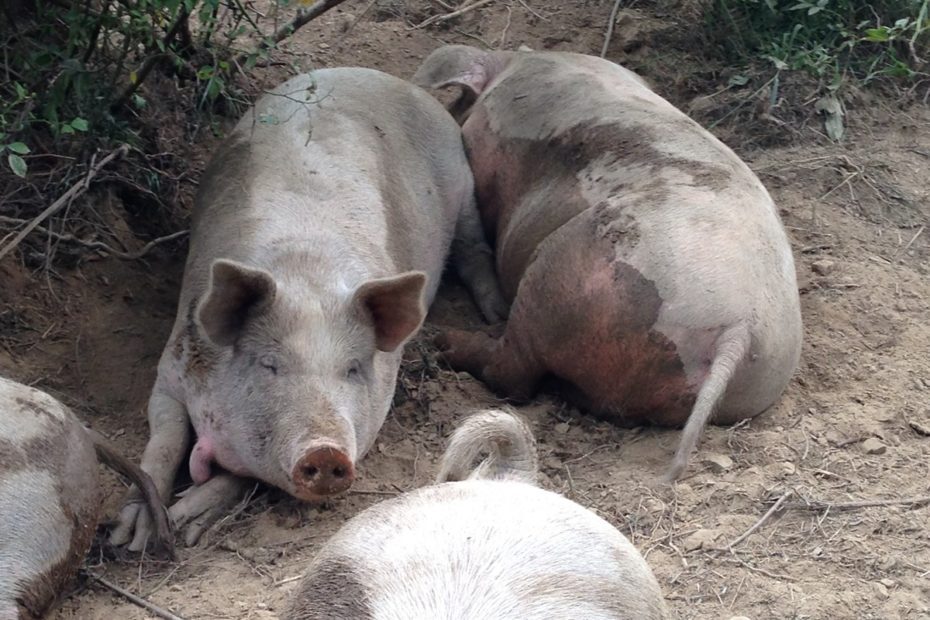This year, not only was there a pig, but also a lamb…
This is a re-run of my post after the event last year in case anyone wants to attend week 2. We talk about nose-to-tail eating, but how does it really work? Come and see what happens when two chefs take on all the parts of a whole pig.
We’ll be focusing on using all the parts of the pig–smoking ribs and bacon, making a variety of sausages and stuffing the head to make headcheese (one of my favorites from last year!).
There’s still time support Slow Food Hudson Valley and get tickets for the second part on Saturday, March 25 from 10-4.
Saturday, the Accidental Locavore and about a dozen people watched three chefs tackle a pig. It was part of a two-day program Slow Food Hudson Valley put on to promote snout-to-tail eating (which reminds me–what happened to the pig’s tail?) or “butchering, preserving and sausage making a heritage pig.
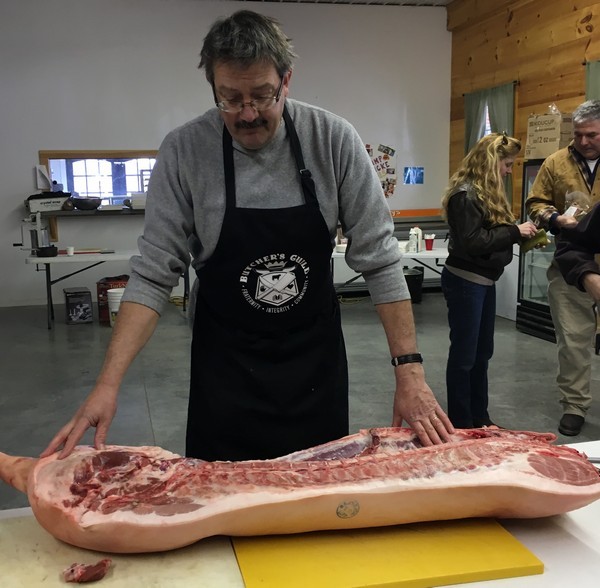 We were in a freezing cold farmstand on Kesike Farms in Red Hook NY, watching Chef Tom work his way through half of a hundred-pound pig. He did it with very few tools, and the ones that he’d chosen were all easily acquired, if not already in your arsenal. For the whole pig all he used were two boning knives, two hand saws and a sharpening steel. One of the hand saws, a Japanese, flexible bladed one, was a recent purchase from Lowes. In case you’re interested in breaking down any sort of animal (bigger than a chicken), remember knife first, then saw.
We were in a freezing cold farmstand on Kesike Farms in Red Hook NY, watching Chef Tom work his way through half of a hundred-pound pig. He did it with very few tools, and the ones that he’d chosen were all easily acquired, if not already in your arsenal. For the whole pig all he used were two boning knives, two hand saws and a sharpening steel. One of the hand saws, a Japanese, flexible bladed one, was a recent purchase from Lowes. In case you’re interested in breaking down any sort of animal (bigger than a chicken), remember knife first, then saw.
As he went through the pig he used a technique he referred to as “seam butchering” or finding the seams between the bones or muscles and using them as reference points. Between American and various European methods, there are a lot of ways to butcher a pig—choices you get to make as you cruise along.
Once Chef Tom got through cutting the pig into his basic cuts, he went back section by section, boning almost everything except the baby back ribs. He showed up his way of tying up various hams and roasts. While he was working, there was a lively discussion of the best ways to use each of the parts. Neck bones (which I forgot to ask for) are supposed to make your regular tomato sauce just amazing! Cumin, for some reason, played a major role in almost everything—it was simply the joke of the day.
After Tom was finished with his business, Chef Dan whisked away a lot of pork for stew and got to work, with help from some CIA students, on our lunch, a southwestern pork stew/chile, which was great and might actually have had some cumin in it…
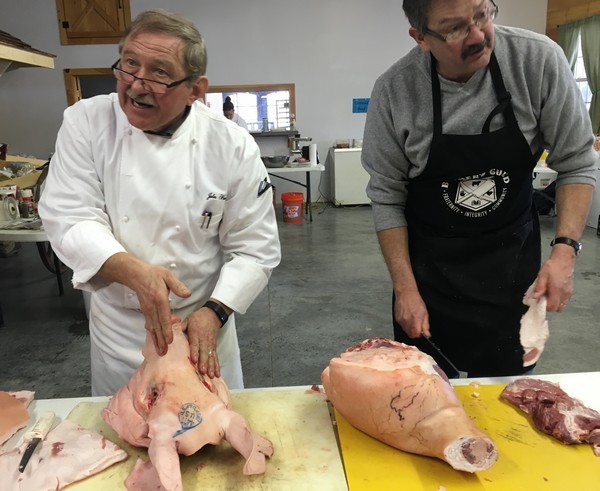 Then Chef John stepped up to demo how to prep the various pork products for bacon, sausages and headcheese (yes, you use the whole head). He made a brine, using some for a loin and injected another piece with brine, explaining when you would inject versus when you would submerge. The liquid injected, should be 10% of the weight of the meat you’re using. The head and feet also went into the brine. We’ll see what happens to them next week.
Then Chef John stepped up to demo how to prep the various pork products for bacon, sausages and headcheese (yes, you use the whole head). He made a brine, using some for a loin and injected another piece with brine, explaining when you would inject versus when you would submerge. The liquid injected, should be 10% of the weight of the meat you’re using. The head and feet also went into the brine. We’ll see what happens to them next week.
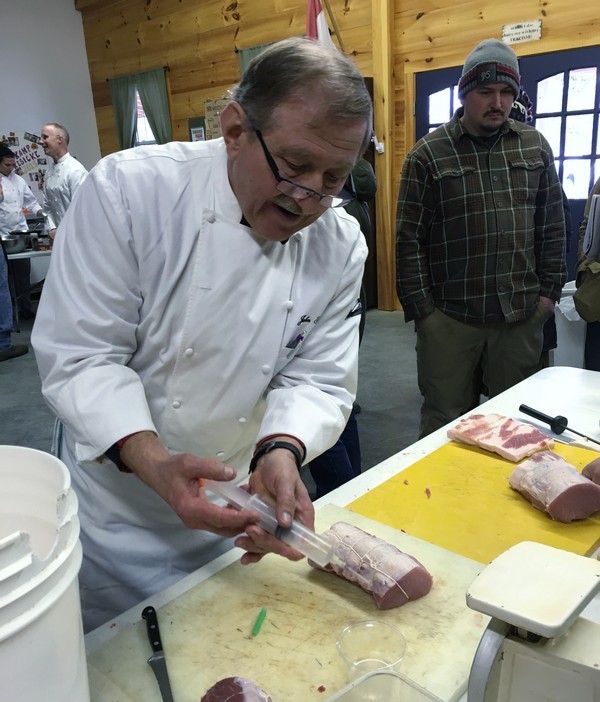 After the brining, John showed us how to do a bacon cure. It’s essentially a dry rub with salt, sugar, and whatever spices you want to add to the mix. You coat the bacon with the cure, cover it (or put it in a Ziploc) and refrigerate. Every other day, you need to flip the meat so it gets cured evenly. Another thing to look forward to next Saturday!
After the brining, John showed us how to do a bacon cure. It’s essentially a dry rub with salt, sugar, and whatever spices you want to add to the mix. You coat the bacon with the cure, cover it (or put it in a Ziploc) and refrigerate. Every other day, you need to flip the meat so it gets cured evenly. Another thing to look forward to next Saturday!
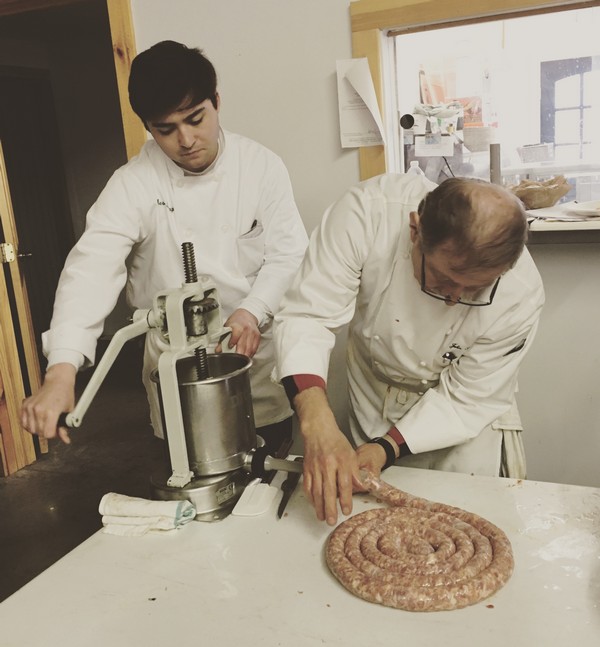 From there we went on to making sausages. When you make sausages, it’s really important to cook and taste the meat before you stuff it. I always thought you just made a mini patty and fried it. No, no, no. Chef John said it’s not a good way to see how the finished product will actually taste and the texture is completely different. His way? Make a sausage-sized log, wrap it tightly in Saran Wrap, and poach it until it’s done. Then taste and adjust the seasonings. We ended the day, tasting his sweet Italian sausages and a southwestern green chile sausage. Both were really great and even better? We got to take some home.
From there we went on to making sausages. When you make sausages, it’s really important to cook and taste the meat before you stuff it. I always thought you just made a mini patty and fried it. No, no, no. Chef John said it’s not a good way to see how the finished product will actually taste and the texture is completely different. His way? Make a sausage-sized log, wrap it tightly in Saran Wrap, and poach it until it’s done. Then taste and adjust the seasonings. We ended the day, tasting his sweet Italian sausages and a southwestern green chile sausage. Both were really great and even better? We got to take some home.
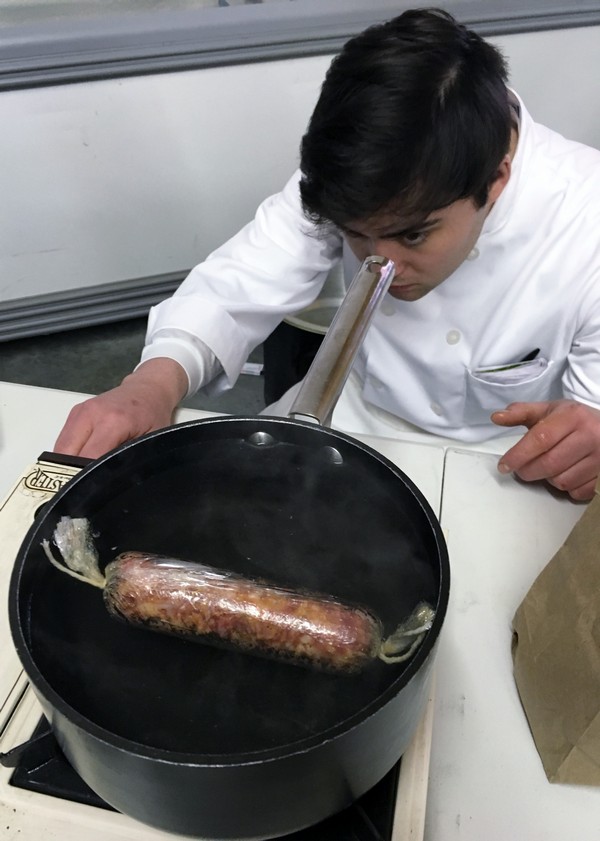 I can’t wait for next Saturday! Lots of smoking going on next week. And we’ll get to try our bacon, make some tasso, have some ribs, even some headcheese. Sound tempting? There are spots available so come join us–Slow Food Hudson Valley has all the info.
I can’t wait for next Saturday! Lots of smoking going on next week. And we’ll get to try our bacon, make some tasso, have some ribs, even some headcheese. Sound tempting? There are spots available so come join us–Slow Food Hudson Valley has all the info.
